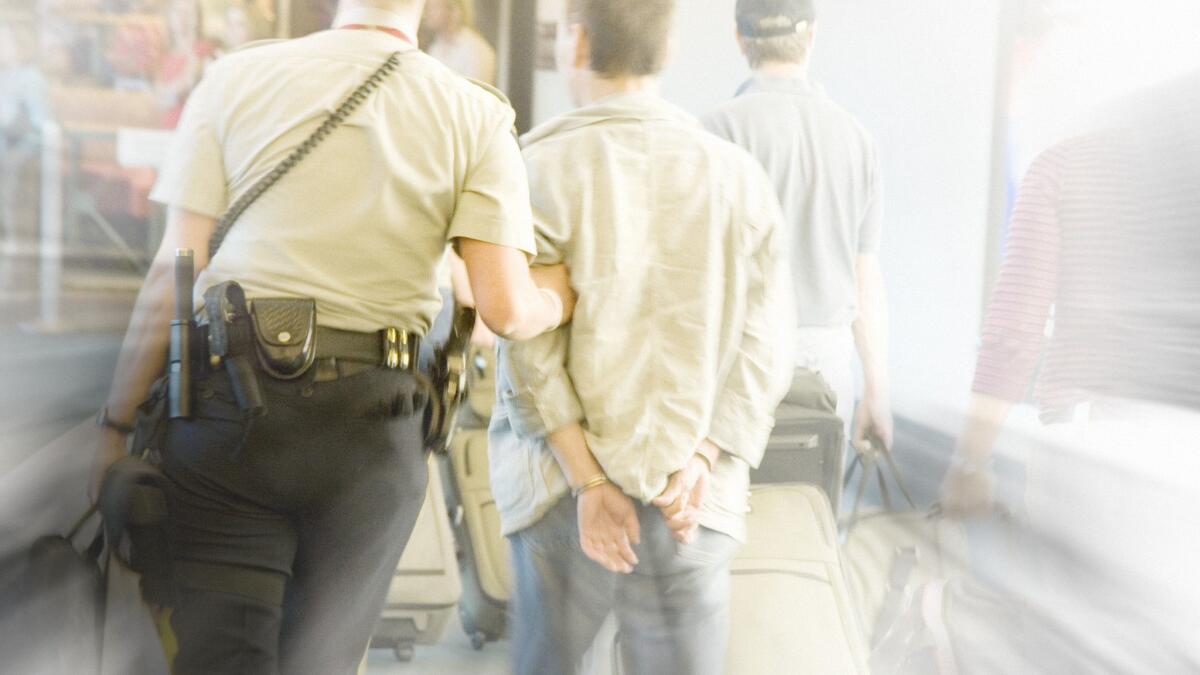What you say on an airplane can get you in deep trouble — and so can what you don’t say

- Share via
Saying the wrong thing to airline staff can get passengers into serious trouble. Tell an off-color joke or make a verbal threat, and a problematic passenger can find himself or herself removed from a flight.
He or she might even get arrested.
Don’t believe this? Consider what happened to Trevor Davis at Los Angeles International Airport.
On April 18, as the 24-year-old Green Bay Packers’ wide receiver checked in for a Hawaiian Airlines flight, an airline employee asked a routine question: Did you pack unapproved items such as aerosols, knives or explosives?
“Yeah,” Davis replied, according to Rob Pedregon, a spokesman for the airport police. Davis then turned to his traveling companion and asked, “Did you pack the explosives?”
Davis was arrested, booked into Los Angeles County Jail and charged with making a false bomb threat at an airport.
Although charges against him were later dropped, Davis’ “joke” is a cautionary tale for those who think bomb threats are funny.
Part of my job as a flight attendant is to report suspicious behavior to the captain. If someone boards the aircraft and jokingly says, “I have a bomb in my bag. Can I get a business-class upgrade?” I am required to report the statement to the captain.
I must do so even if I think the passenger is joking — even if I know the passenger is joking.
When it comes to airline security, nothing is left to interpretation.
If you say you have an explosive device in your bag, airline staff is required to treat you as though you have an explosive device in your bag.
Recently, during the boarding process on my flight to Saõ Paulo, Brazil, a middle-aged American man expressed outrage about something that happened on his previous flight. As he stepped through the boarding door, he said, “When this plane lands, I’m gonna shoot every employee at [this airline].”
The flight attendant stationed at the boarding door heard the threat. So did several passengers. The flight attendant reported the incident to the captain, who immediately called police.
Two police officers interrogated the passenger on the jet bridge. I stood within earshot, concerned that someone who threatened to shoot me and my colleagues might try to downplay the seriousness of his statement.
One of the officers asked the man whether he had made the verbal threat.
“Well … not exactly,” the man replied. “I said, ‘When this plane lands, I hope somebody shoots every employee at [this airline].’”
I couldn’t believe what I had heard.
By saying he hoped somebody would commit a horrific act of violence against innocent people instead of admitting that he expressed the desire to do so, he was trying to deflect blame.
It appears his ploy worked. The officers decided not to arrest him. After consulting with the flight attendants — all of whom took the threat seriously — the captain asked the officers to remove the passenger from our aircraft.
The gate agent also initiated procedures to permanently ban the passenger from flying on the airline.
Sometimes, it’s what a passenger doesn’t say that will get him removed from the aircraft.
At the conclusion of every onboard safety video, the Federal Aviation Administration requires flight attendants to walk through the cabin and ensure that seat belts are fastened, tray tables are stowed and seats are in their upright position.
Most passengers are familiar with the process. Yet during one flight, when my colleague asked a particular passenger to stow his tray table, he stared ahead blankly and refused to respond.
Concerned, she asked whether he was OK.
He didn’t answer. He continued to stare at the seat back in front of him.
Her concern deepened.
She stowed his tray table and repeatedly asked whether there was a problem. He never answered, instead staring ahead as though he were in a trance.
Unsure about how to proceed, she summoned me. There were no hearing impaired passengers on the passenger information list, so that wasn’t the issue. The man’s behavior was certainly suspicious
“Sir,” I said, “why aren’t you responding? We need a response from you.”
The man looked at me briefly and continued to stare ahead.
As we taxied toward the runway, I moved to the front of the aircraft and described the situation to the purser. She confronted the passenger, explaining that refusing to respond to a crew member’s request could be grounds for removal.
“I need you to respond before takeoff,” she said. “Please talk to me.”
Still, the passenger chose not to speak.
Moments later, the captain announced that we were returning to the gate.
When the aircraft door opened and uniformed officers escorted the man from the aircraft, he spoke for the first time.
“What’s the big deal?” he asked.
More to Read
Sign up for The Wild
We’ll help you find the best places to hike, bike and run, as well as the perfect silent spots for meditation and yoga.
You may occasionally receive promotional content from the Los Angeles Times.






